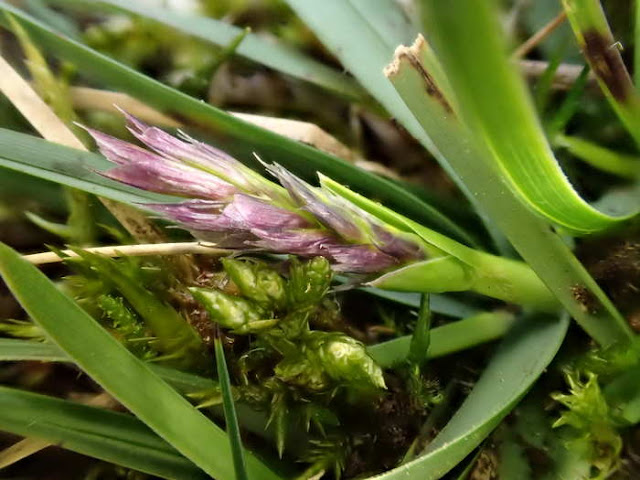Grass of the Month- March
I started the grasses section of this blog in 2010 - in the International Year of Biodiversity, this blog is featuring a different British Grass each month - Follow these pages and you will be come an expert in grasses too... well, a little more knowledgeable maybe!! See grasses index
Grass of the month 1: January - Reed Canary Grass - Phalaris arundinacea Grass of the month 2: February - The Common Reed - Phragmites australis
Grass of the month 3: March - Blue Moor-grass Sesleria caerulea
Grass of the month 4: April - Sweet Vernal Grass - Anthoxanthum odoratum
March: Blue Moor-grass (Sesleria caerulea)
 |
| 17 Feb 2023 - carpark Winskill Stones Pavement - the flowerhead is just emerging |
 |
| Blue Moor-grass in May- growing with my favourite moss - Breutelia chrysocoma |
Blue Moor-grass grows on limestone cliffs and scree slopes in NW Yorkshire (especially the Craven Area), Cumbria and Lancashire, in a few places in Scotland and in the limestone areas of Ireland, and in the Alps...
Blue Moor-grass does not grow in the south of England so botanists come all the way up here from London to see this Craven speciality.
Until recently, it had not been found south of Yorkshire , but now a site has been found for it in Derbyshire. It seems to grow in base-rich areas once covered by glaciers.
It is the first grass to come out into flower (apart from annual meadow-grass which flowers all year).
For six months of the year - October to April the temperature is too cold for plants to grow in Craven. Growth requires a temperature of 6º C.
However, this special grass is starting to put it bluey-purple head out in March. Indeed, if you split open a Blue Moor-grass shoot in November or December you will find the baby flower inside - it is the only grass in the UK to do that. The limestone places where Sesleria grows can become very dry in summer as water sinks through the cracks in the limestone. The plant puts resources into getting the plant to flower and fruit early before there is a drought.
Any grass in flower in March or early April growing in limestone pavement or on our limestone cliffs in Craven must be Blue Moor-grass.
How to recognise Sesleria before it is in flower:- However, this special grass is starting to put it bluey-purple head out in March. Indeed, if you split open a Blue Moor-grass shoot in November or December you will find the baby flower inside - it is the only grass in the UK to do that. The limestone places where Sesleria grows can become very dry in summer as water sinks through the cracks in the limestone. The plant puts resources into getting the plant to flower and fruit early before there is a drought.
Any grass in flower in March or early April growing in limestone pavement or on our limestone cliffs in Craven must be Blue Moor-grass.
Go to limestone cliffs in Craven or Cumbria or Lancashire: e.g. Winskill Stones, Gordale Scar, and look for:-
- a tufted grass that has leaves about 6mm wide;
- that are folded as they emerge and have slightly boat shaped tips.
- There are whitish persistent sheaths at the base of the shoot.
- The blades curve like a scythe - sometimes upwards, sometimes downwards, and often bluish
- .They have a little point on the tip of the leaf.
Here you can see I had fun taking pictures of Blue Moor-grass with a scanner.
coming shortly
One of the beautiful plants that can grow with Blue Moor-grass is Purple Saxifrage.Two years ago it was in flower by March 5th. This year, with more snow still forecast we will be lucky if it is out by April 5th.
coming shortly

 The Common Reed
The Common Reed 

 Reeds are used for thatching and reed beds make good nature reserves.
Reeds are used for thatching and reed beds make good nature reserves.  29 Jan 2010 Here are Reeds at Malham Tarn fen at 385 m above Sea Level. Their growth was restricted to an old trout breeding pool but inthe last 15 years they have started marching out across the botanically very rich fen..
29 Jan 2010 Here are Reeds at Malham Tarn fen at 385 m above Sea Level. Their growth was restricted to an old trout breeding pool but inthe last 15 years they have started marching out across the botanically very rich fen..